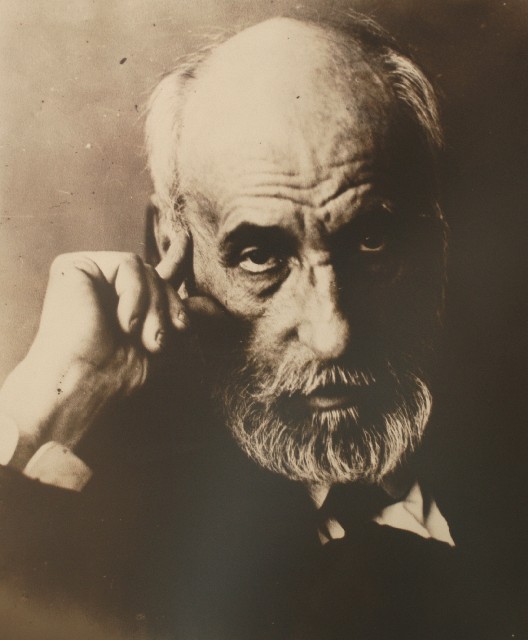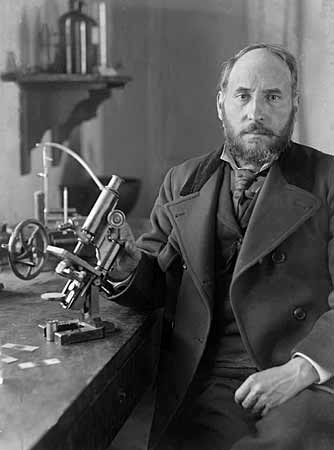<Back to Index>
- Physician Santiago Ramón y Cajal, 1852
- Architect Benjamin Henry Boneval Latrobe, 1764
- General and High Commissioner of Palestine Sir Alan Gordon Cunningham, 1887



Santiago Ramón y Cajal (1 May 1852 – 17 October 1934) was a Spanish histologist, physician, pathologist and Nobel laureate. His pioneering investigations of the microscopic structure of the brain were so original and influential that he is considered by many to be the greatest neuroscientist of all time. His skills as an artist allowed him to make hundreds of drawings still used for educational purposes today.
The son of Justo Ramón and Antonia Cajal, Ramón y Cajal was born of Aragonese parents in Petilla de Aragón in Navarre, Spain. As a child he was transferred between many different schools because of his poor behaviour and anti-authoritarian attitude. An extreme example of his precociousness and rebelliousness is his imprisonment at the age of eleven for destroying the town gate with a homemade cannon. He was an avid painter, artist, and gymnast. He worked for a time as a shoemaker and barber, and was well known for his pugnacious attitude.
Ramón y Cajal attended the medical school of Saragossa, Aragon, from which he graduated in 1873. After a competitive examination, he served as a medical officer in the Spanish Army. He took part in an expedition to Cuba in 1874-75, where he contracted malaria and tuberculosis.
After returning to Spain he married Silveria Fañanás
García in 1879, with whom he had four daughters and three sons.
He was appointed as a professor of the Universidad de Valencia in 1881, and in 1883 he received his Doctor of Medicine degree in Madrid. He later held professorships in both Barcelona and
Madrid. He was Director of the Zaragoza Museum (1879), Director of the
National Institute of Hygiene (1899), and founder of the Laboratorio de Investigaciones Biológicas (1922) (later renamed to the Instituto Cajal, or Cajal Institute). He died in Madrid in 1934. Ramón y Cajal's early work was accomplished at the Universities of Zaragoza and Valencia where he focused on the pathology of inflammation, the microbiology of cholera,
and the structure of epithelial cells and tissues. It was not until he
moved to the University of Barcelona in 1887 that he learned Golgi's silver nitrate preparation and turned his attention to the central nervous system.
During this period he made extensive studies of neural material
covering a large variety of species and most major regions of the brain. Ramón
y Cajal made several major contributions to neuroanatomy. He discovered
the axonal growth cone, and provided the best evidence supporting Auguste Forel's
theory of nerve cell contact. He provided detailed descriptions of cell
types associated with neural structures, and produced excellent
depictions of structures and their connectivity. He was an advocate of
the existence of spines, although he did not recognize them as the site
of contact from presynaptic cells. He was a proponent of polarization
of nerve cell function and his student Lorente de No would continue this study of input/output systems into cable theory and some of the earliest circuit analysis of neural structures. Ramón y Cajal was a fierce defender of the neuron theory. Among his many distinctions and societal memberships, Ramón y Cajal was also made an honorary Doctor of Medicine of the Universities of Cambridge and Würzburg and honorary Doctor of Philosophy of Clark University. He published over 100 scientific works and articles in French, Spanish, and German. Among his most notable were Rules and advices on scientific investigation, Histology, Degeneration and regeneration of the nervous system, Manual of normal histology and micrographic technique, Elements of histology, Manual of general Anatomic Pathology, New ideas on the fine anatomy of the nerve centres, Textbook on the nervous system of man and the vertebrates, and The retina of vertebrates. In 1905, he published five science-fictional "Vacation Stories" under the pen name "Dr. Bacteria." In 1906 he was awarded the Nobel Prize in Physiology or Medicine together
with an Italian man of science Golgi 'in recognition of their work on
the structure of the nervous system'. This was seen as quite
controversial owing to the fact that Golgi, a stout reticularist, disagreed
with Cajal in his view of the neurone doctrine. The asteroid 117413 Ramonycajal is named in his honour.